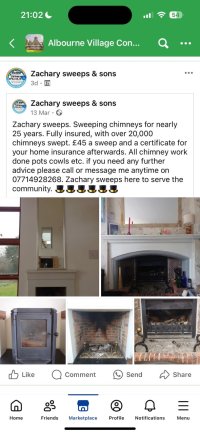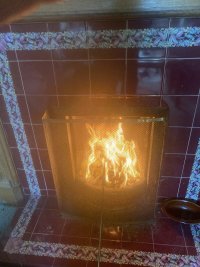As I'm a chimney sweep and stove installer I'd better answer! Sounds like you've got it about right. Drain rods, e.g. the blue ones, tend to be a bit too stiff but will do if there aren't any too tight bends. They won't really flex enough go thru a stove - tend to break the stove/pipe seal, even using a stovepipe soot door.
Your brush sounds ok, you need it to be fairly soft but needs to be bigger than the flue - brickwork chimneys tend to be 8 1/2 to 9inch across so you need a 13 inch brush to get the diagonals (but will still miss some). The softness also enables you to wind it around until small enough to go thru the pot at the top at least once.
The British Standard for sweeping (yes, really) is three passes, but if you've gone thru the pot once that is generally ok. Then 2 more up/downs without getting thru the pot. It is important to get it through once, otherwise you might think you are at the pot when it is actually a birds nest - one Sweep went to jail for failing to do this - several CO's deaths, due to birdsnest and probable compacting by the sweeps brush.
The key to getting around bends is to keep rotating clockwise with a bit of upwards force but not too much. Eventually the end will "walk" around the bend enough to continue sweeping. Ditto coming back down if it jams - often does. When you change direction to come back down inside the flue, the brush has to go from an upward arrow shape to a downward one. - Needs a pretty good pull to flex the bristles the other way, ditto getting back down the pot from outside, but pots very rarely come off.
Your kink at 10m is probably/normally where the chimney brickwork a) goes thru 45 degrees in the attic and also b) narrows and goes above the roof.
Take it easy, there's no rush.
I advise you not to use a vacuum, soot is very fine and clogs/burns out motors unless you got very fine filters, normal ones are usually not ok. Use anything, with a hole for the rod, across the fireplace, sealed up with masking tape. (Remember to put the first rod in and the brush on before you seal it up - Doh! How many times....)
Aftywards give it a knocking to shake off soot before opening up. Open up first only 1/3 at the top, sweep around the fireplace shelf and sides first, lots there. Partial opening improves draw/ reduces spillage. Get a bin bag, sides rolled down, open and ready below the fireplace to catch/put the soot/sand in. Gently pull the sheet down and fold it into itself to catch the dirty side, take it outside for a shake. Dig out the soot and sand etc from the fireplace with a soft handbrush and small shovel or garden trowel. Ditto empty ash pan. gently unroll bag sides, tie and dispose. Wood ash in the garden is fertiliser, smokeless ash goes in the bin or to keep weeds down on a path.
Finally, and most importantly, check the bloody CO alarm is up and working!!
Have a coffee and congratulate yourself.
I allow one and a half hours per sweep, and the going rate in Berkshire is generally £70/sweep. Birds nests are by the hour as sizes can vary enormously. My Pro sweep kit and Vacuum now cost over £5K and it's seasonal work. Rich I ain't!


